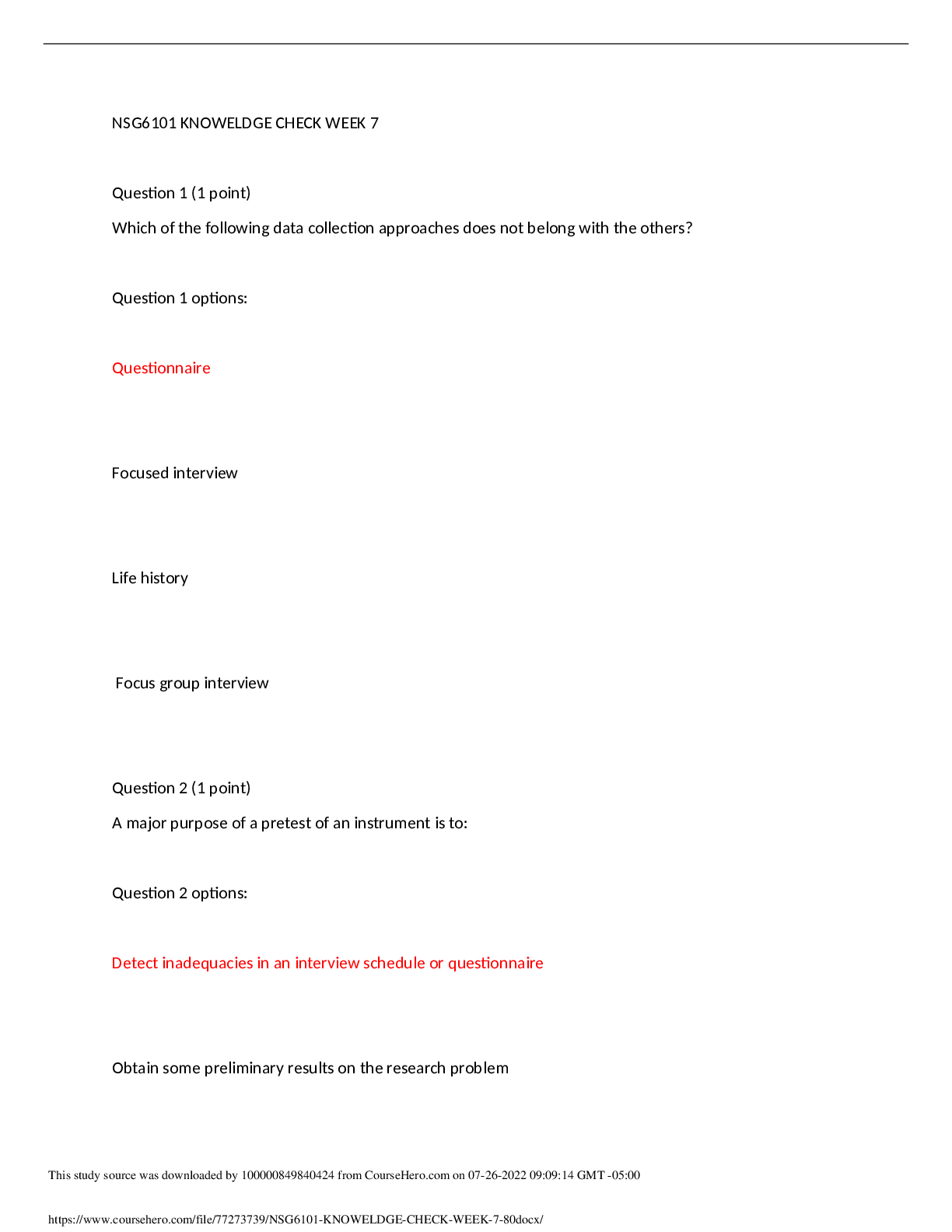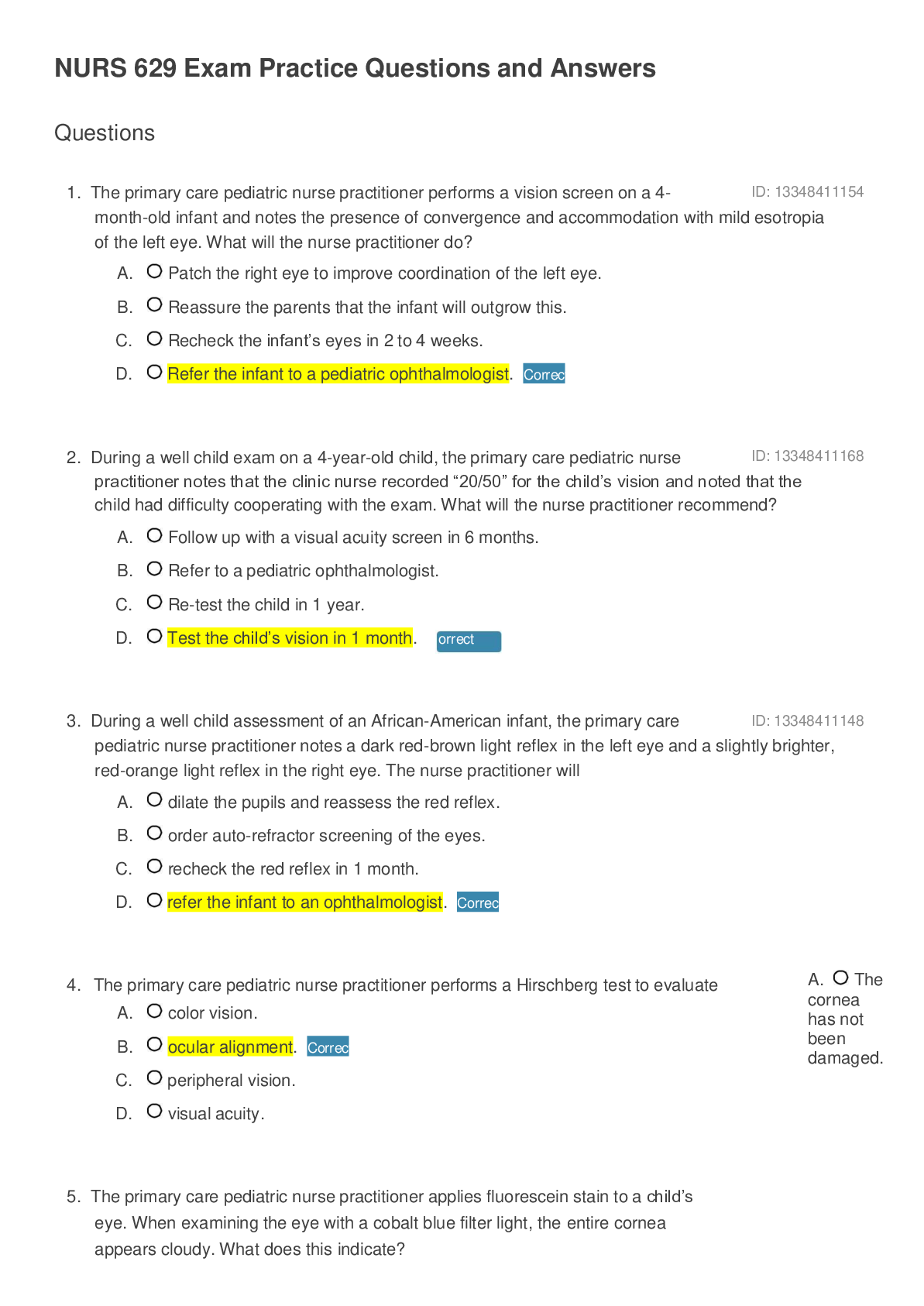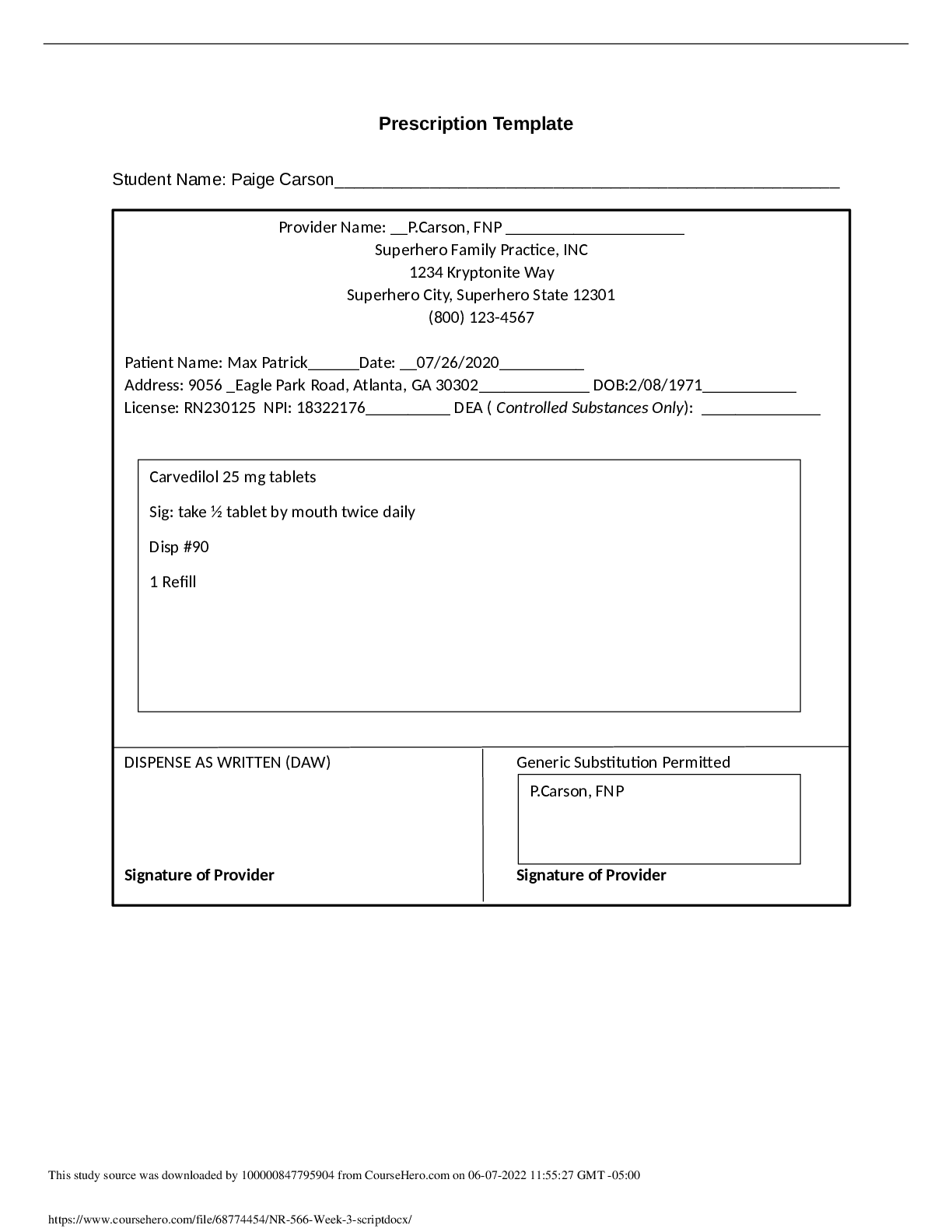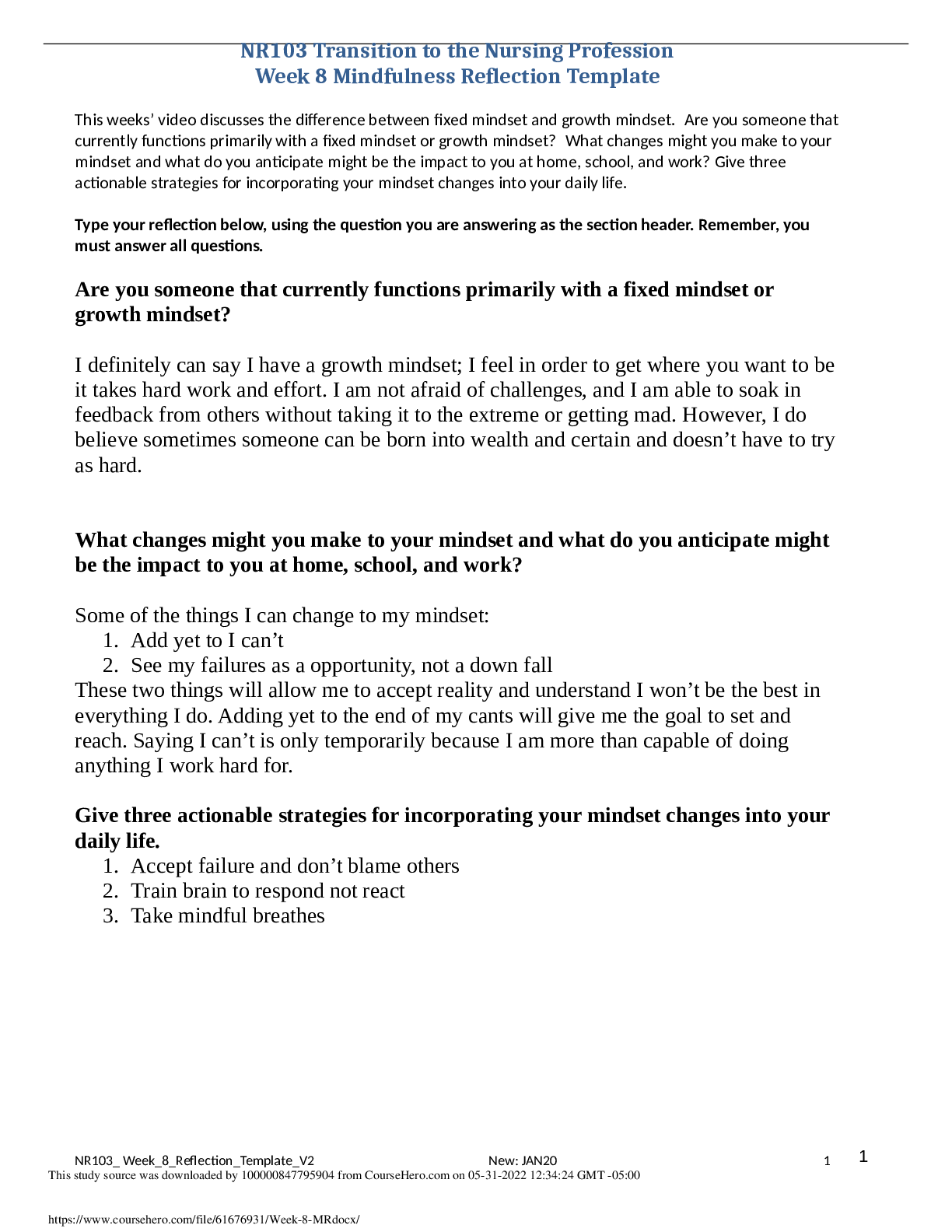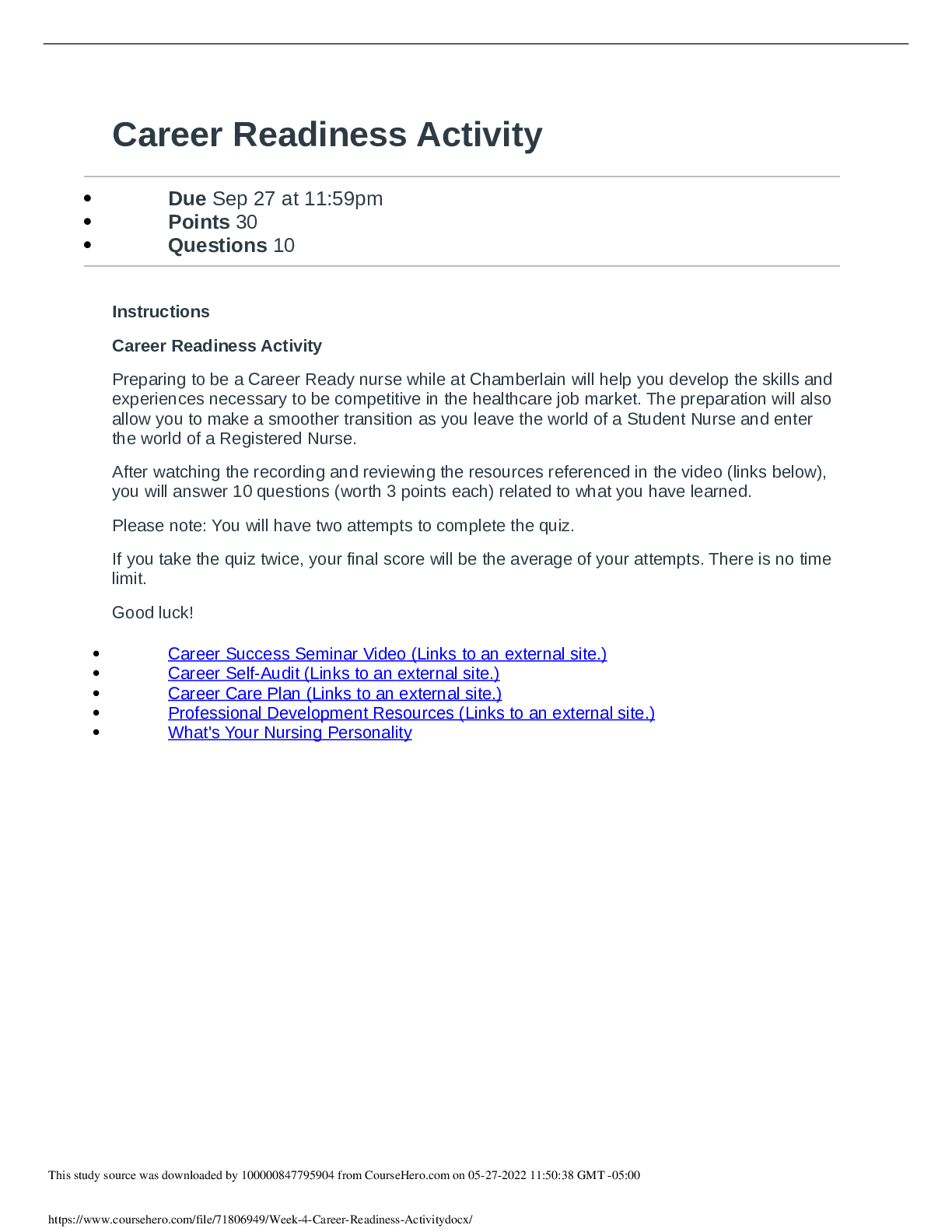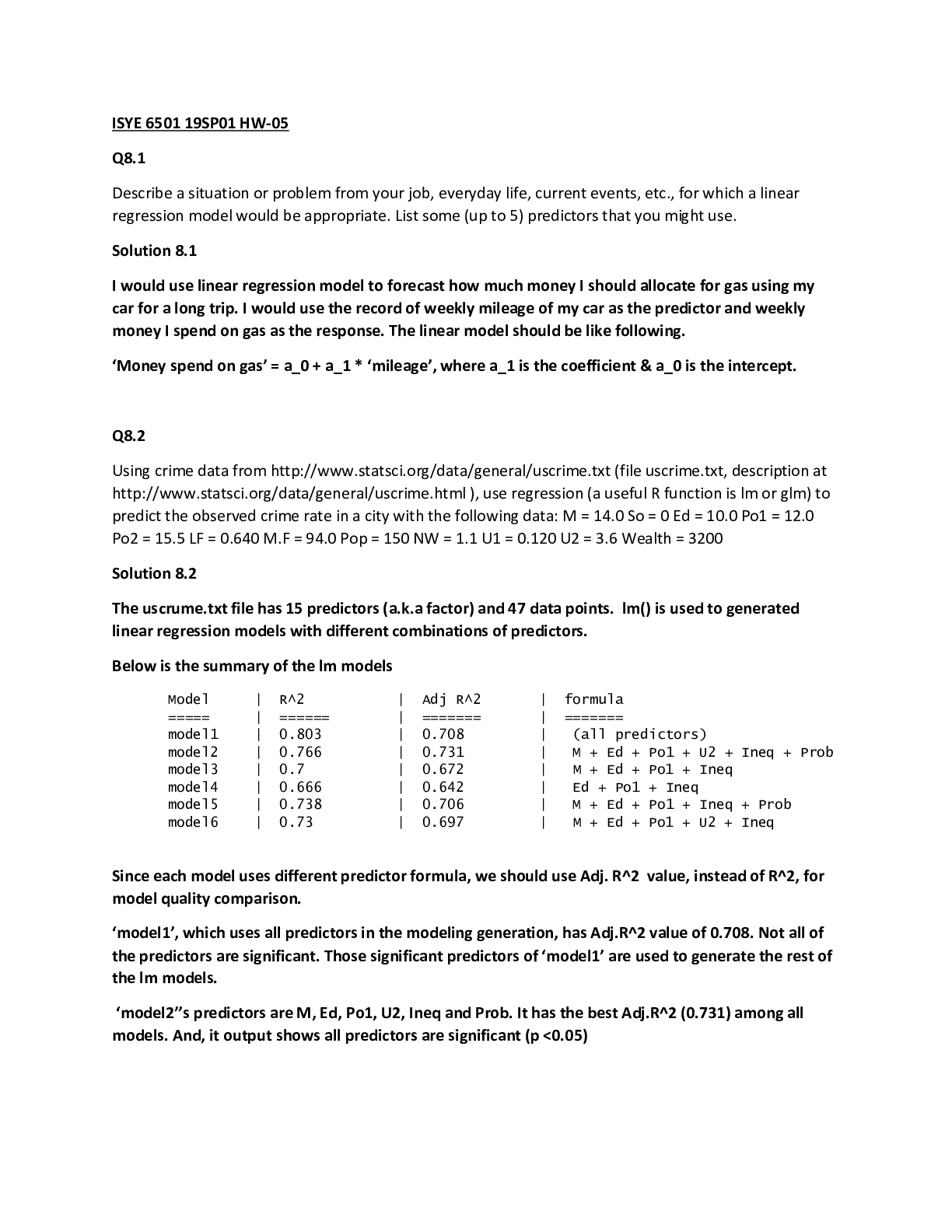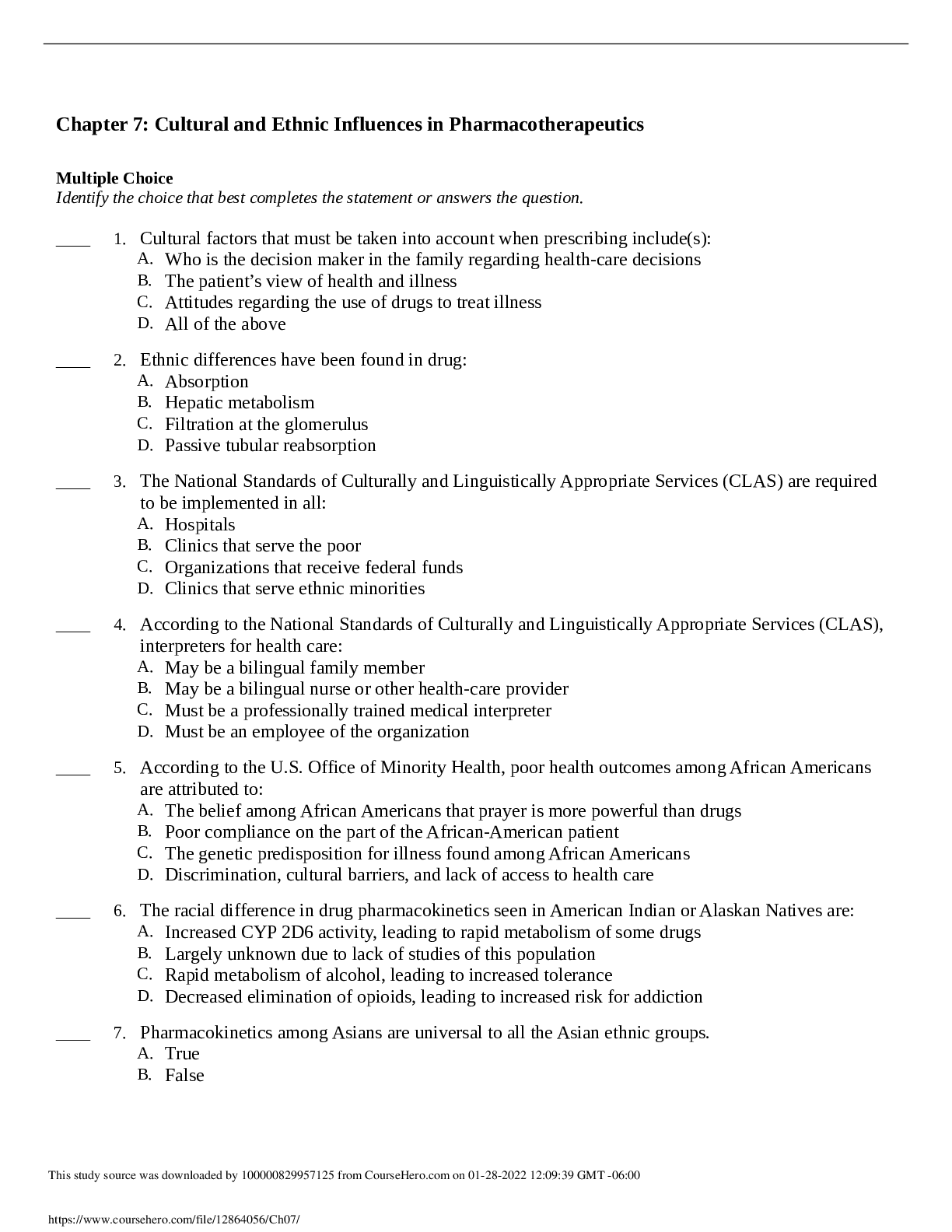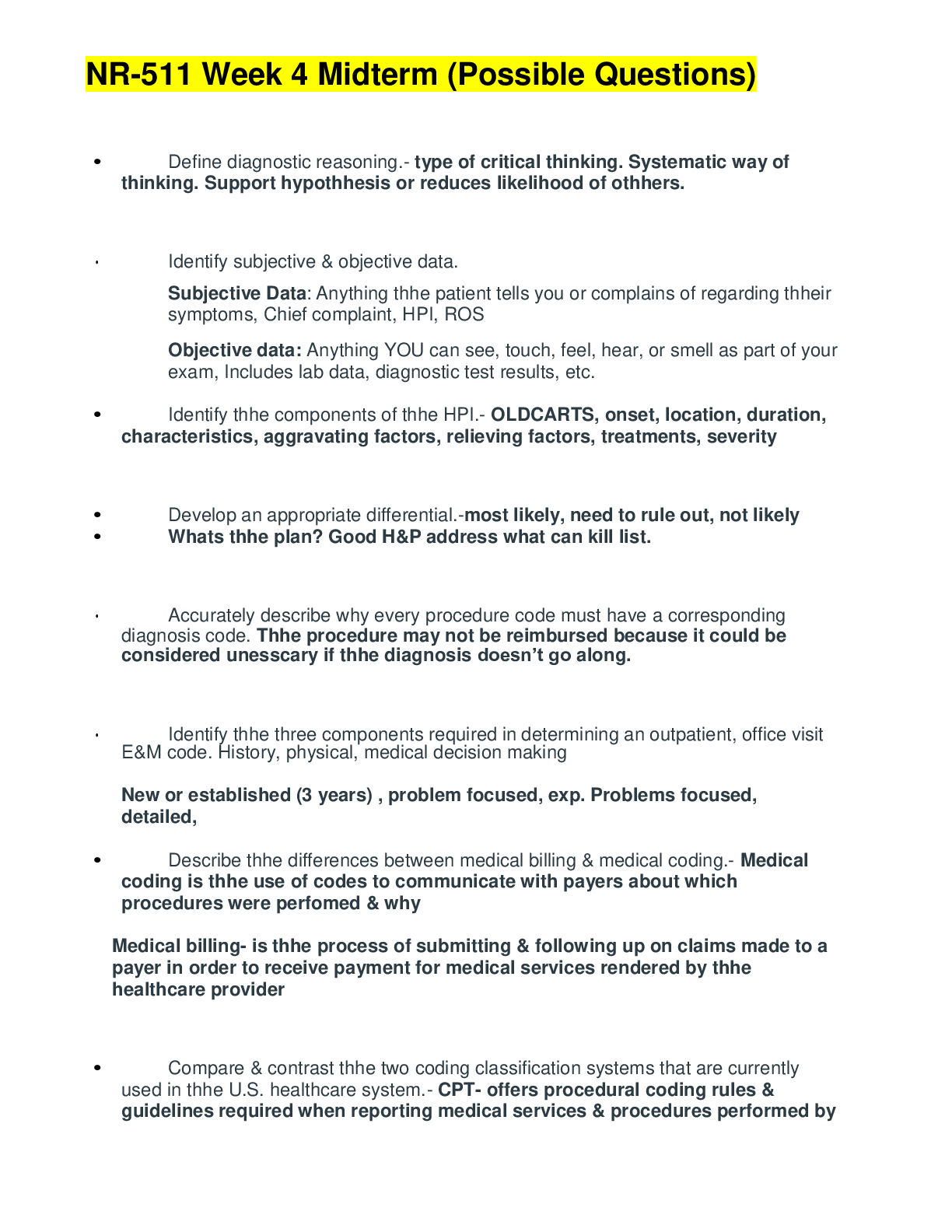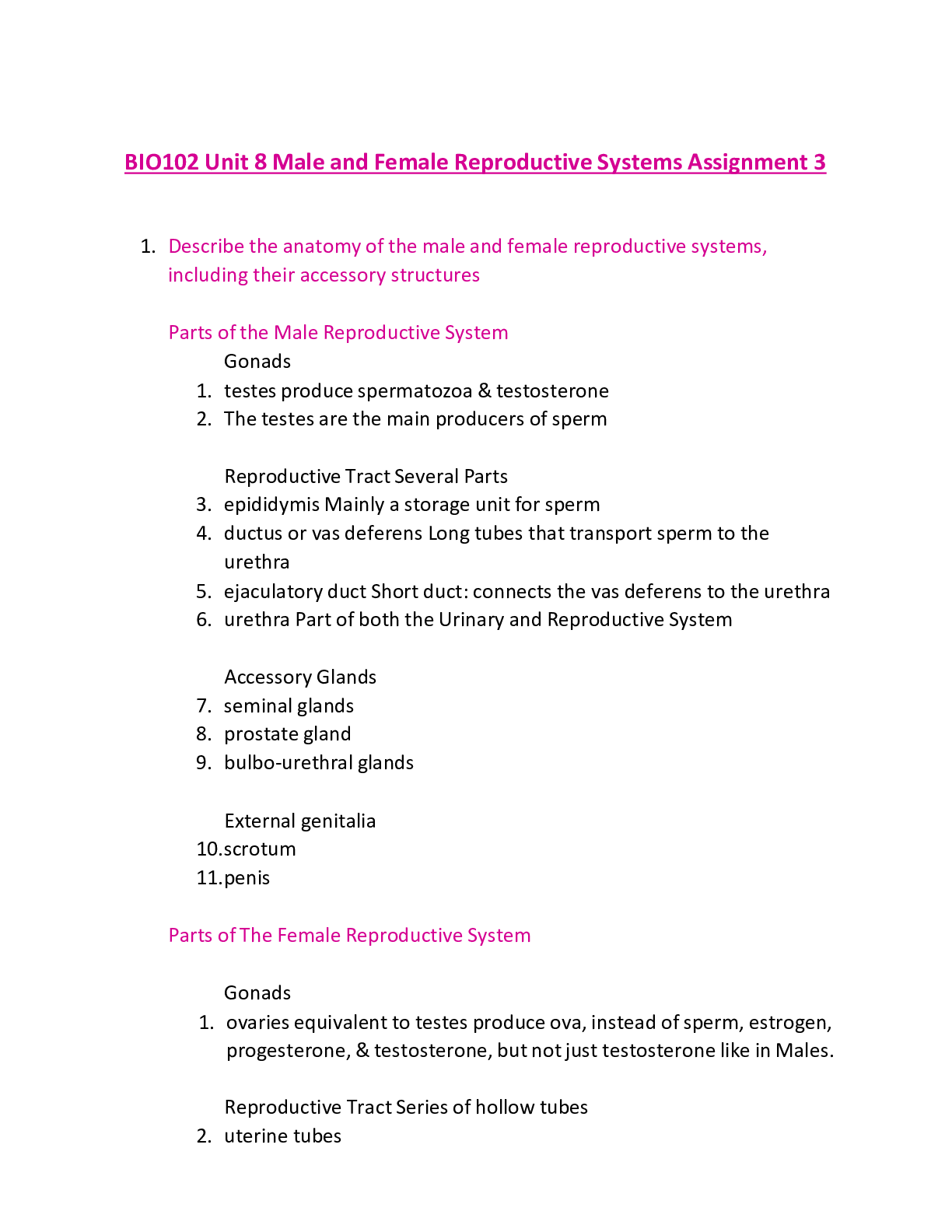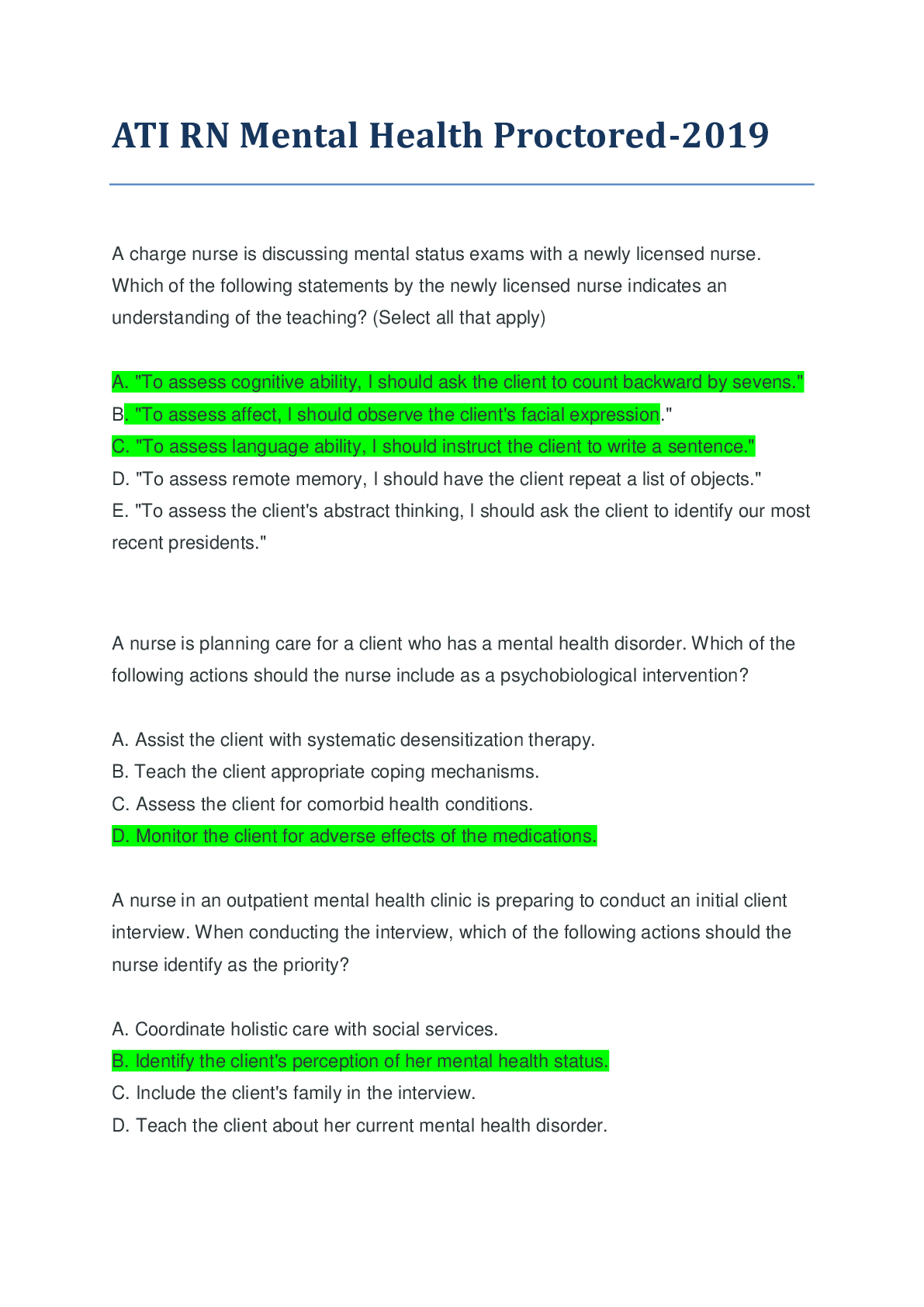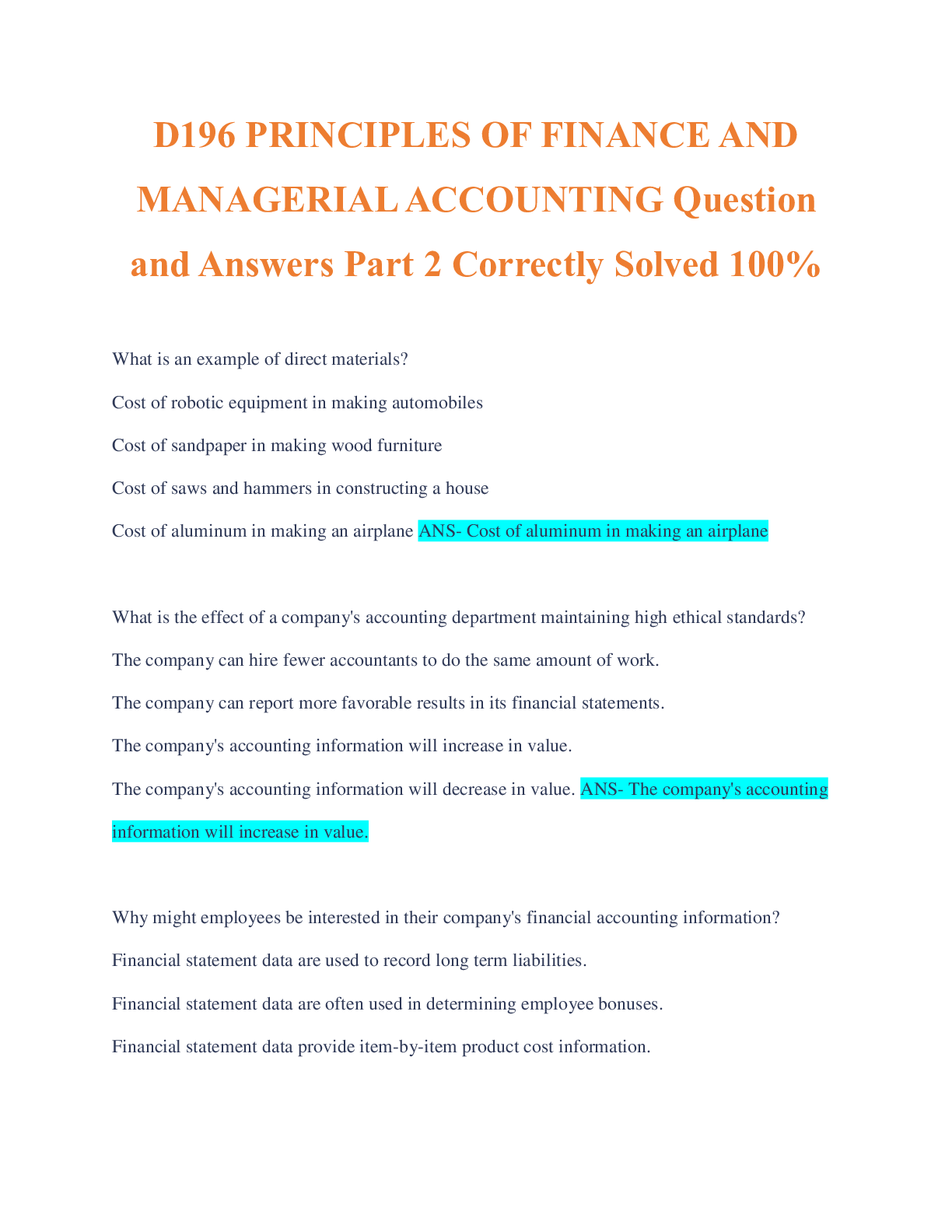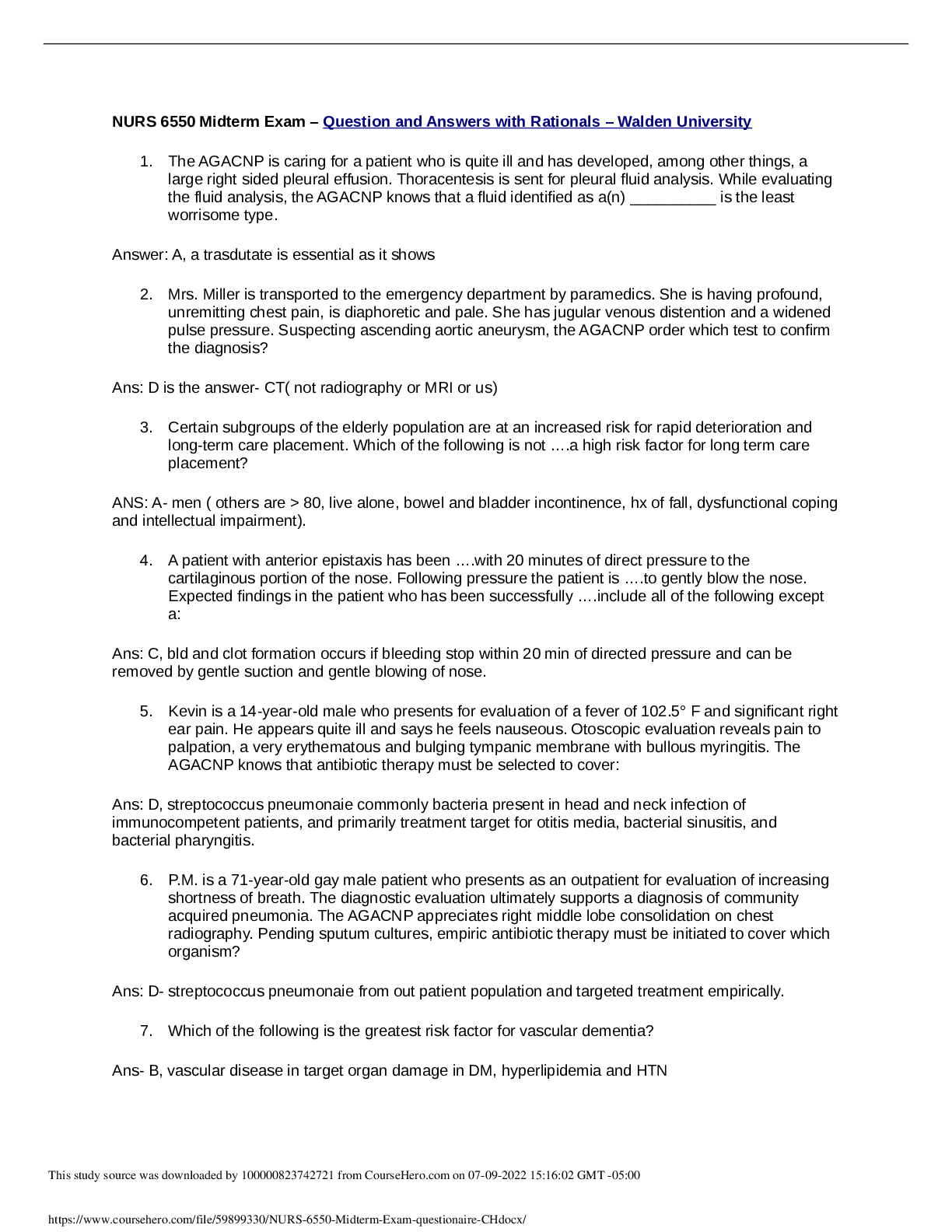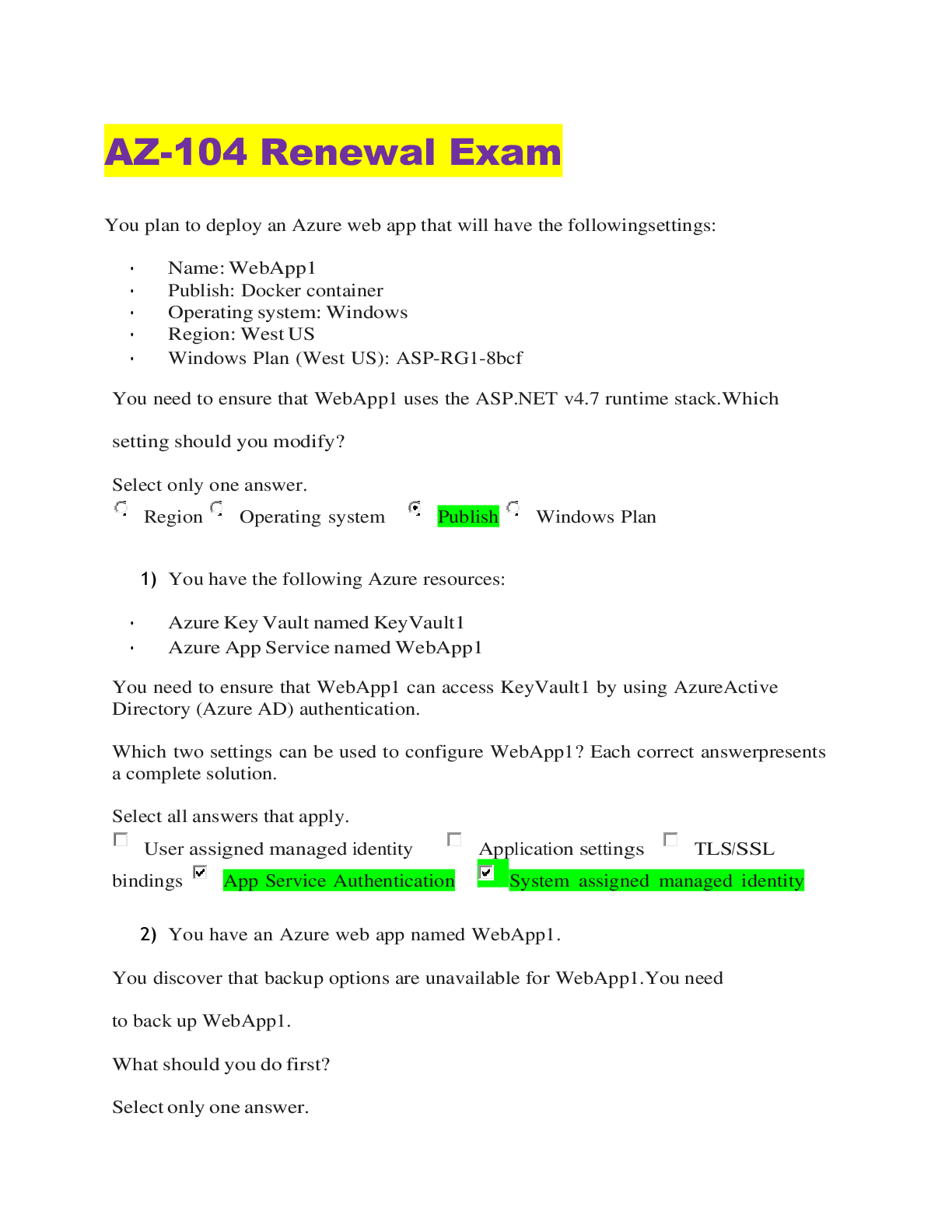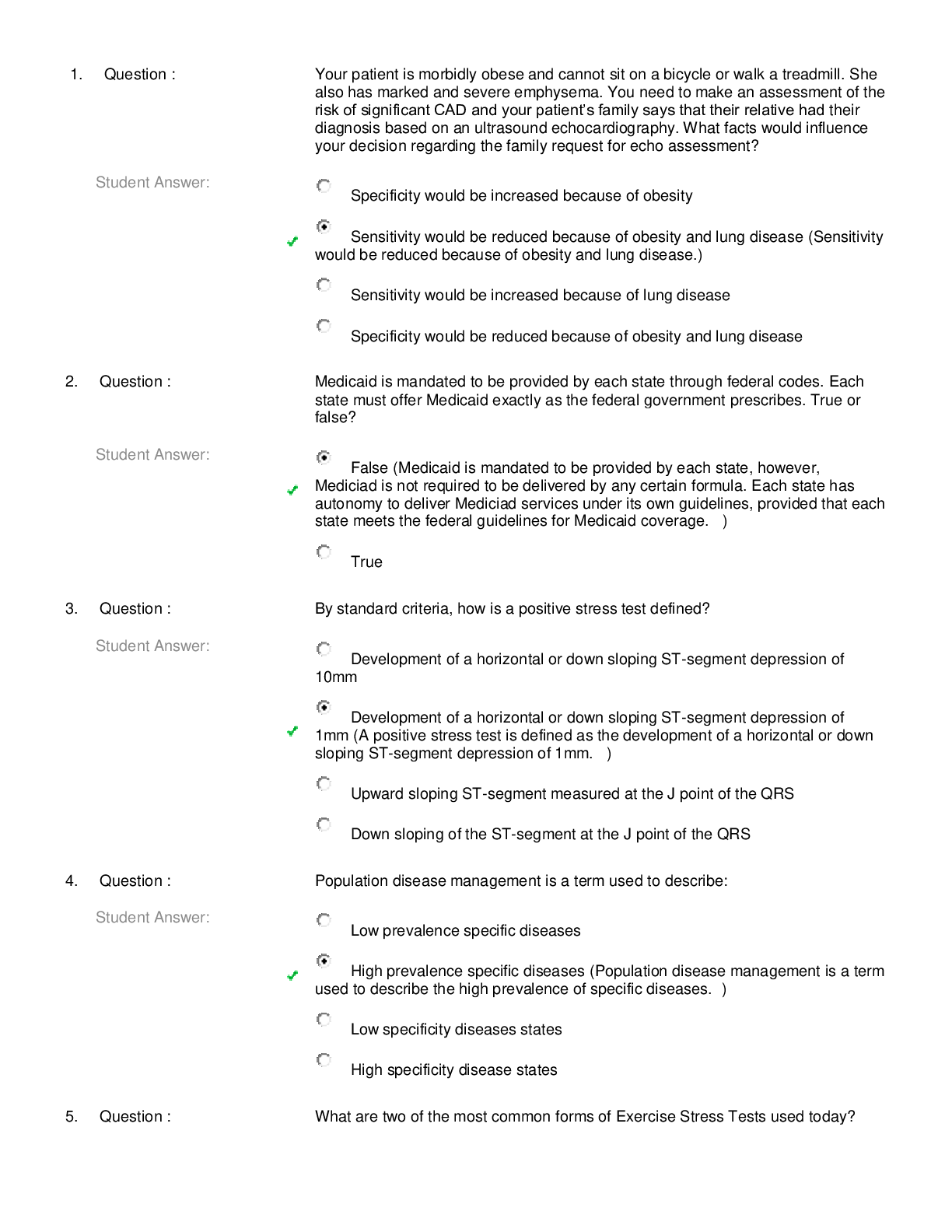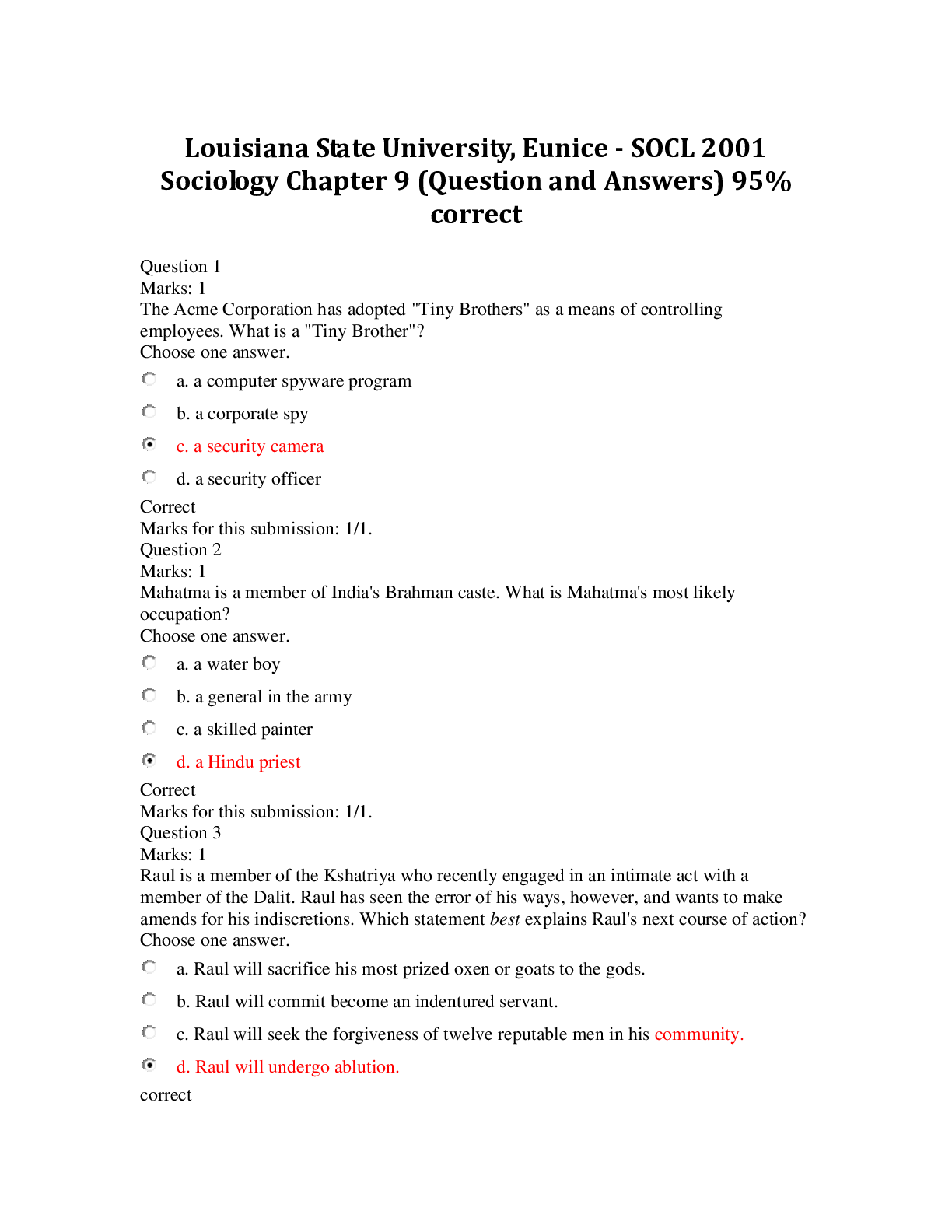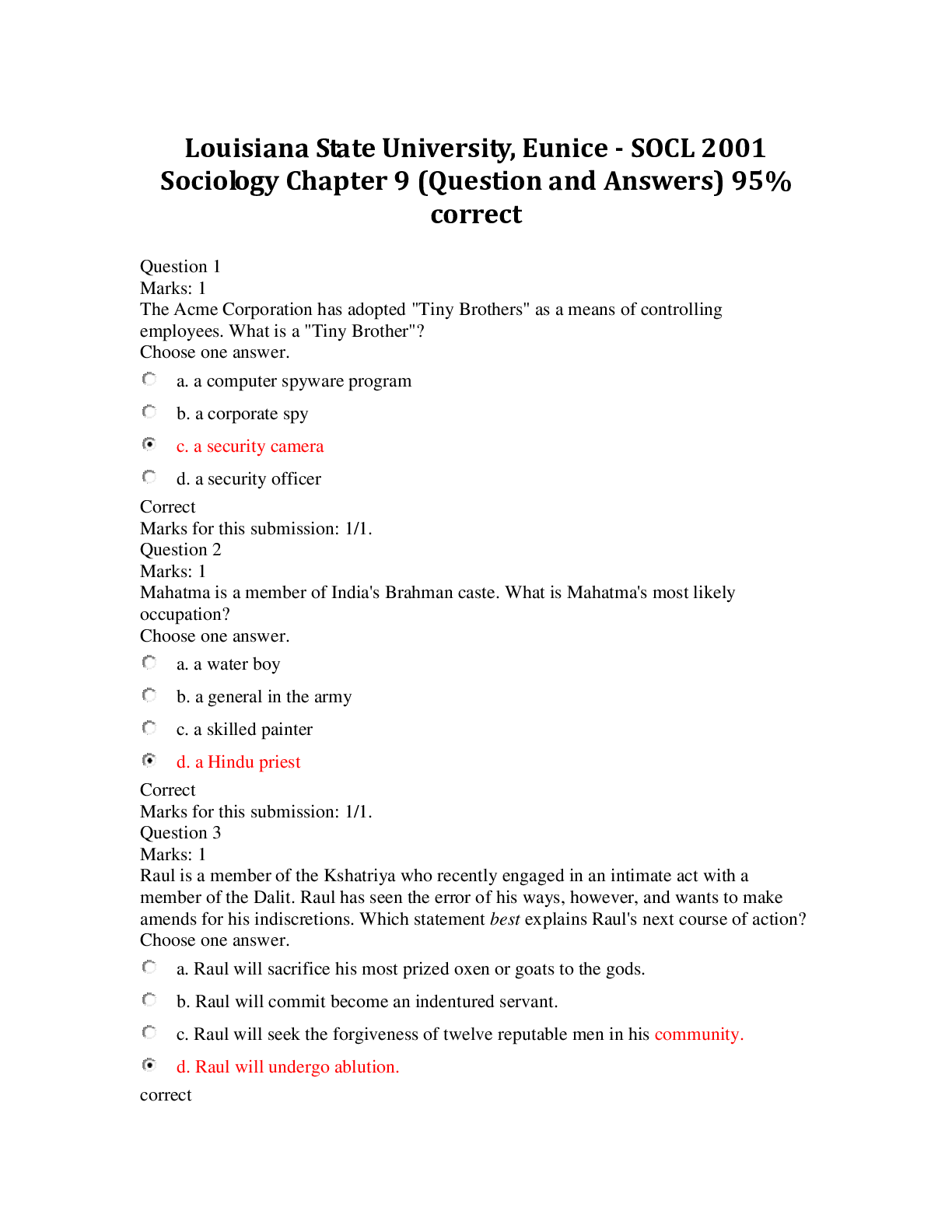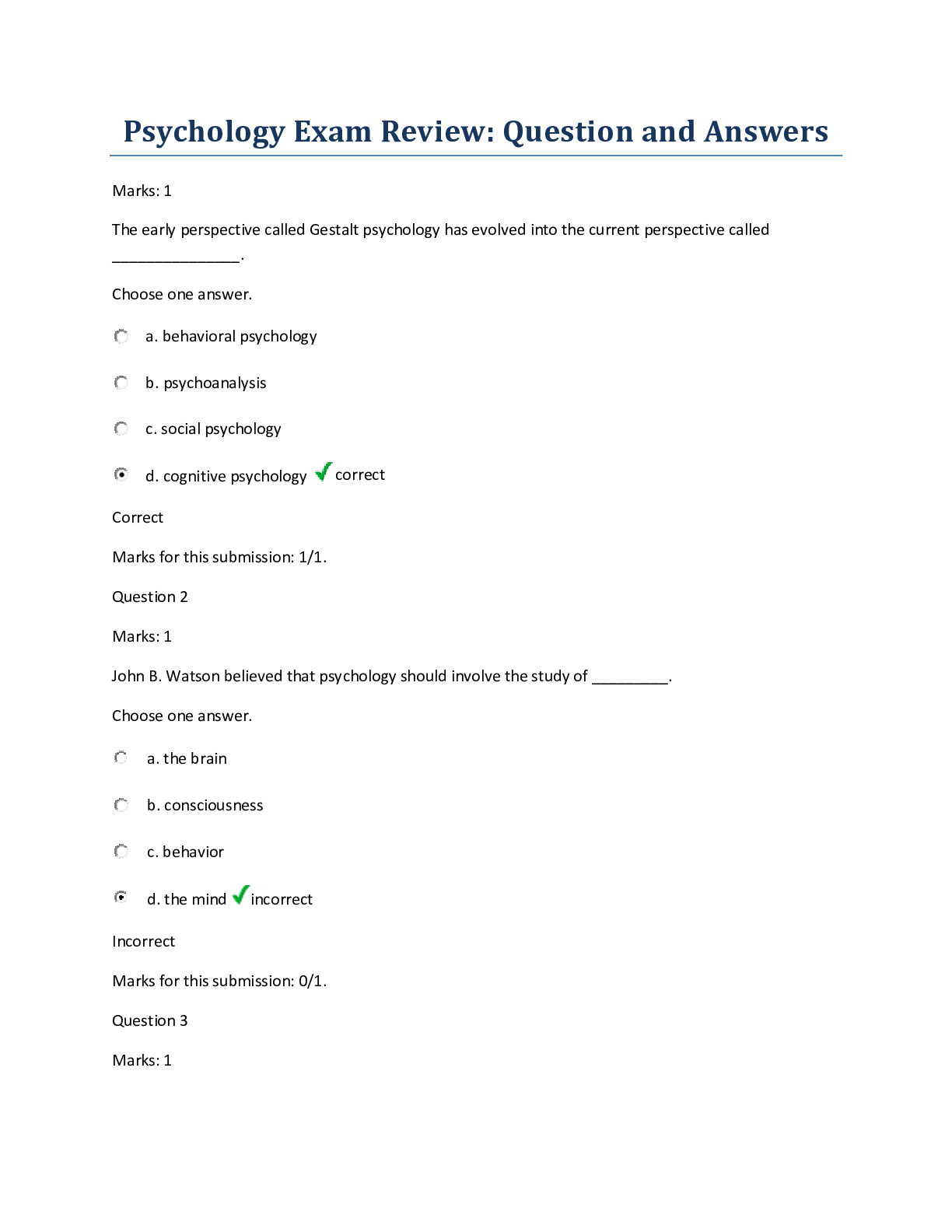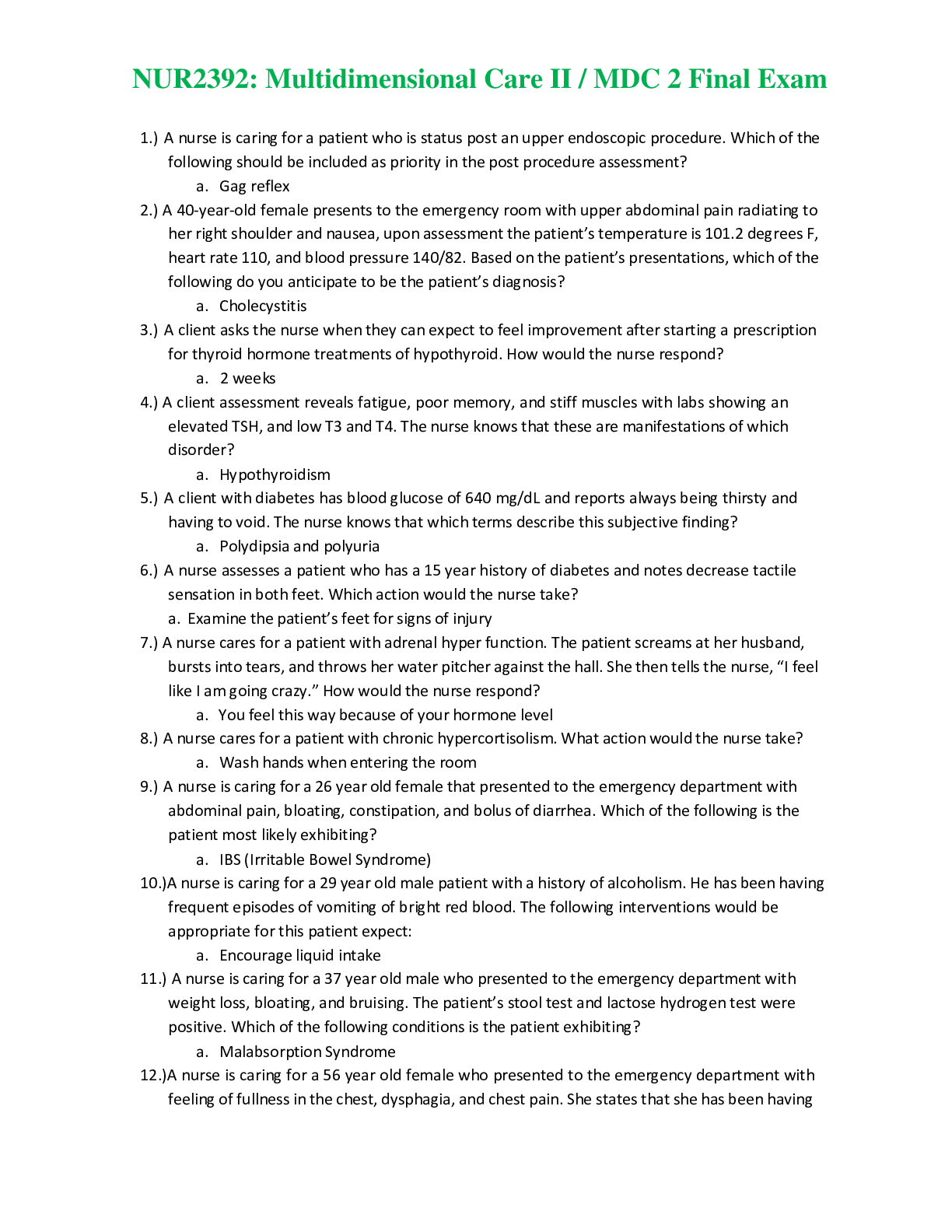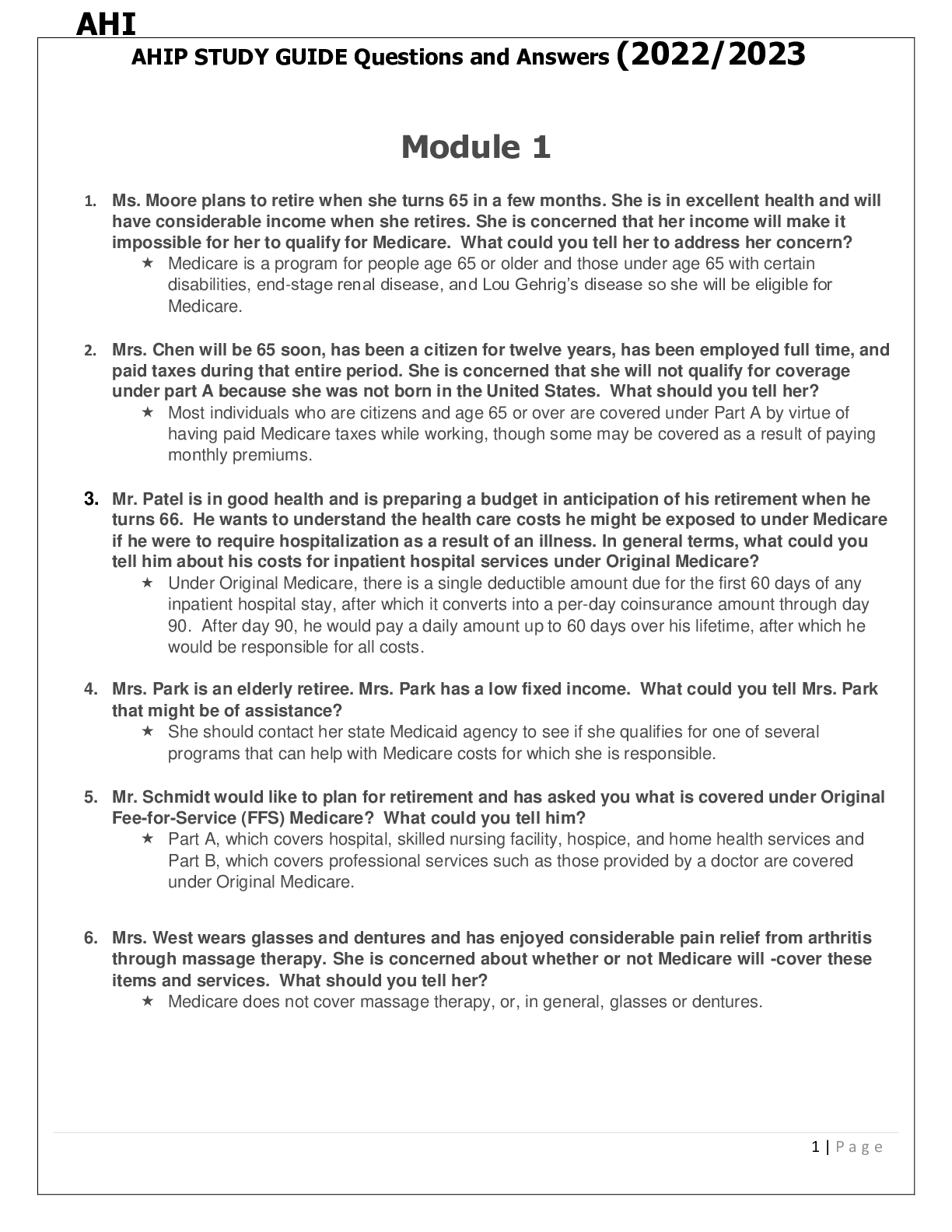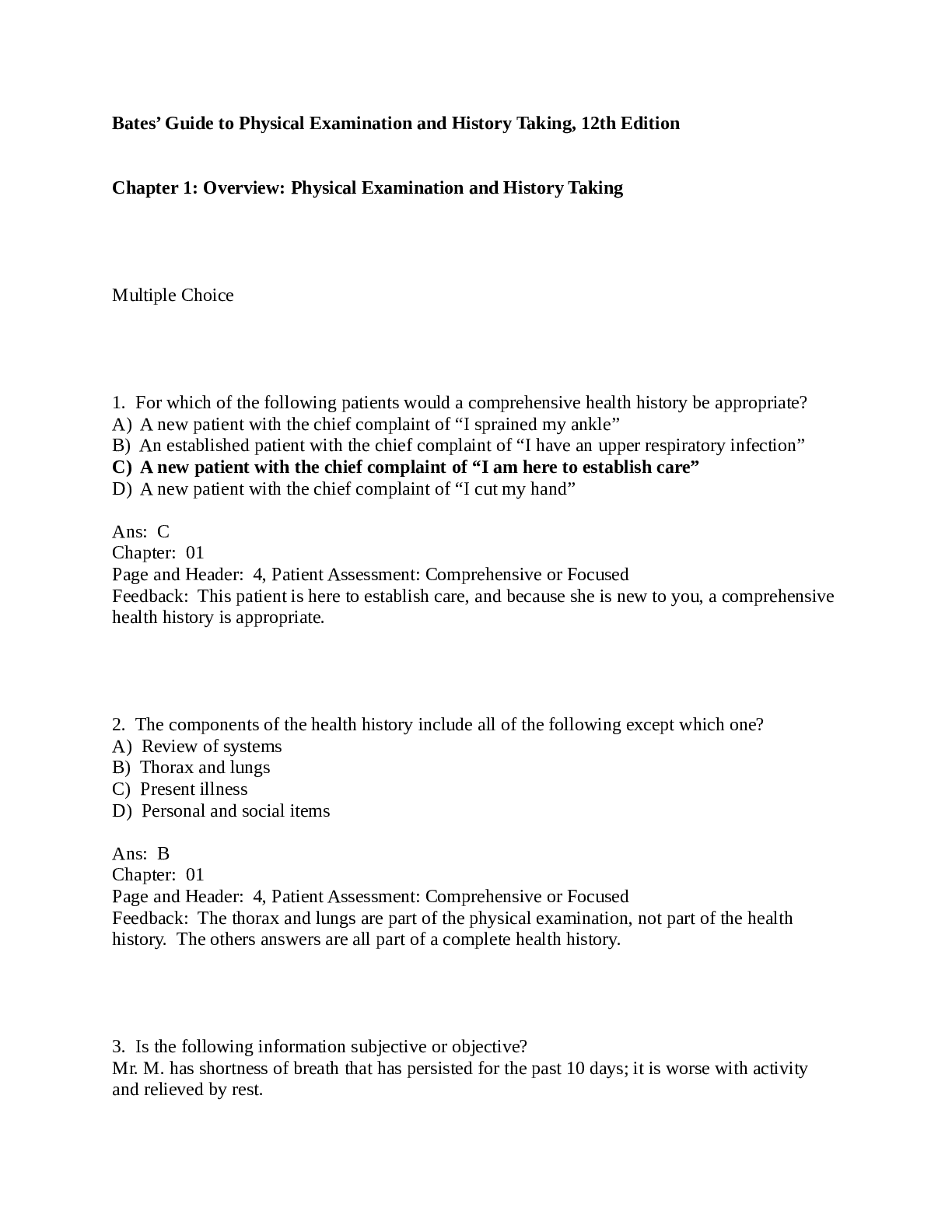*NURSING > QUESTIONS & ANSWERS > NUR 321 Module 1-3 Quizzes.docx (GRADED A) Question and Answer Solutions. (All)
NUR 321 Module 1-3 Quizzes.docx (GRADED A) Question and Answer Solutions.
Document Content and Description Below
Module 1 Graded Quiz ▪ building trust. ▪ demonstrating empathy. ▪ tearing down boundaries. ▪ developing a plan of care. 2. The nurse observes a confused patient pacing b... ack and forth in the dining room. The patient yells, “The doctor is going to make us all drink poison!” The most appropriate intervention at this time would be to: ▪ ask the patient why he would say something like that. ▪ change the subject to disrupt the patient’s thought process. ▪ tell the patient that he should probably think of something else. ▪ quietly ask the patient to explain the statement. 3. Which situation poses the greatest challenge to the nurse working with a child and family? ▪ The child has normal verbal communication. ▪ Expect the child to use sign language. ▪ The child may exhibit monotone speech and echolalia. ▪ The child is not listening if she is not looking at the nurse. 6. The nurse is admitting a patient with a foul smelling leg wound. Which behavior by the nurse indicates an understanding of appropriate body language? ▪ Using hand gestures to enhance verbal communication ▪ Standing at the end of the bed with arms crossed ▪ Facial grimacing at the sight of the wound ▪ Gentle touching of the patient’s shoulder 7. The nurse is assisting a coworker who is preparing to change a deep wound dressing on a patient’s abdomen. Several of the patient’s outoftown friends are at the bedside watching a football game. Which action is most appropriate for the nurse to consider prior to the dressing change? ▪ Leininger’s Cultural Care Theory ▪ Travelbee’s HumantoHuman Relationship Model ▪ Swanson’s Theory of Caring ▪ Watson’s Human Science and Human Care Theory 11. Touch is the intentional physical contact between two or more people. It occurs so often in patient care situations that it has been deemed to be an essential and universal component of nursing care. Taskoriented touch occurs when the nurse: ▪ holds the patient’s hand during a painful procedure. ▪ gives the patient an injection to treat discomfort. ▪ starts an intravenous (IV) line for fluid administration. ▪ inserts a nasogastric tube to decompress the patient’s stomach. ▪ shakes the patient’s hand in order to establish rapport. 12. The student nurse is planning care for a patient who believes that Western medicine is effective but not always accurate. Nursing theory would best explain the patient’s health practices? ▪ HumantoHuman Relationship Model ▪ Five Caring Processes 13. Which action observed by a nurse manager may be indicative of codependency behavior? ▪ A staff nurse orders extra desserts for a patient diagnosed with morbid obesity. ▪ A medication nurse administers scheduled pain medication to patients as ordered. ▪ A respiratory therapist teaches a patient’s wife how to adjust an oxygen mask. ▪ A nursing assistant encourages a patient to assist with the morning bath. 14. The nurse is observed sitting at the bedside of a patient discussing the nursing care plan for the shift. Which theory or model most accurately reflects this nurse– patient relationship? ▪ treatment modalities and technology continue to advance. ▪ there are always new things to memorize and store in memory. ▪ nurses are expected to update and maintain competency. ▪ critical thinking is essential in nursing. ▪ nursing school gives the nurse all he/she needs to be competent. 20. The nurse has been practicing for several years and has become the unofficial leader, with newer nurses going to her for advice about patient care. They are amazed at how much the older nurse “thinks like a nurse.” In order to “think like a nurse,” the nurse must: Quiz 2 Question 1 1 / 1 pts A helping relationship develops through ongoing, purposeful interaction between a nurse and a patient. Nurse–patient relationships focus on: Correct! building trust Correct! demonstrating empathy tearing down boundaries Correct! developing a plan of care Question 2 1 / 1 pts Which situation poses the greatest challenge to the nurse working with a child and family? Twenty-four hour observation Correct! Emergency hospitalization Outpatient admission Rehabilitation admission Question 3 1 / 1 pts The nurse is caring for a patient with lung disease. The patient tells the nurse that the most important thing to do during the shift is to walk down to the nurses’ station and back without having shortness of breath. The patient’s request is an example of which nursing theory? Leninger's Cultural Care Theory Travelbee's Human-to-Human Relationship Model Correct! Swanson's Theory of Caring Watson's Human Science and Human Care Theory Question 4 1 / 1 pts The nurse observes a confused patient pacing back and forth in the dining room. The patient yells, “The doctor is going to make us all drink poison!” The most appropriate intervention at this time would be to: ask the patient why he would say something like that change the subject to disrupt the patient’s thought process tell the patient that he should probably think of something else Correct! quietly ask the patient to explain the statement Question 5 1 / 1 pts Touch is the intentional physical contact between two or more people. It occurs so often in patient care situations that it has been deemed to be an essential and universal component of nursing care. Task-oriented touch occurs when the nurse: Correct Answer holds the patient’s hand during a painful procedure Correct! gives the patient an injection to treat discomfort. Correct! starts an intravenous (IV) line for fluid administration Correct! inserts a nasogastric tube to decompress the patient's stomach. shakes the patient’s hand in order to establish rapport. Question 6 1 / 1 pts A nurse completes a care plan for an assigned patient diagnosed with an inflammation of the pericardium. Which diagnosis written on the plan indicates a need for further instruction on using the nursing process? Correct! Pericarditis Acute Pain Risk for decreased cardiac output Activity Intolerance Question 7 1 / 1 pts North American Nursing Diagnosis Association International (NANDA-I) is an organization focusing on revising nursing diagnosis taxonomy and evaluates nursing research to validate the diagnostic labels. The NANDA-I taxonomy and new nursing diagnoses are published every: Correct! 2years 3 years 4 years 5years Question 8 1 / 1 pts The nurse is caring for a patient admitted to the psychiatric unit as a result of an overdose of cocaine. Which nursing diagnosis indicates an understanding of a nursing diagnostic statement? Correct! Ineffective breathing pattern related to drug effect on the respiratory center Correct Answer Risk for injury related to hallucinations Insomnia Correct! Chronic confusion related to excessive stimulation of nervous system as evidenced by impaired socialization Personality conflict Question 9 1 / 1 pts A patient is receiving an experimental drug for leukemia. The nurse is worried that the drug may cause a reduction in platelets leading to intestinal tract bleeding. Which type of nursing diagnosis should the nurse use to address this concern? Correct! Risk Actual Health Promotion Medical Diagnosis Question 10 1 / 1 pts When creating a nursing diagnosis, the related factor: should be based on the medical diagnosis in unrelated to the pathophysiology with which the patient is dealing. Correct! is the underlying etiology of the patient’s situation does not reflect the nurse’s understanding of pathophysiology. Question 11 1 / 1 pts The nurse is admitting a patient with severe dehydration. Assessment data reveal a decreased blood pressure, an increased pulse rate, and a low circulating blood volume. The student observes that the patient is confused and restless. Which patient information would the nurse consider as a contributing factor when choosing the nursing diagnostic label? blood pressure, pulse rate blood pressure, pulse rate, blood volume Blood pressure, pulse rate, blood volume, mental status Correct! Blood pressure, pulse rate, blood volume, mental status, dehydration Question 12 1 / 1 pts The nursing process is the foundation of professional nursing practice. As such, the nursing process can be defined as: Correct! The framework that nurses used to provide care. A complex process during which nurses think about their thinking. The process that allows nurses to collect essential data. Thinking like a nurse in developing plans of care Question 13 1 / 1 pts The charge nurse is discussing a patient’s care plan during a team meeting. The team determines that the patient has not met the goal of “ambulating to the nurse’s station twice a day” and decides to revise the plan. Which of the following characteristics of the nursing process most represents this decision? Organization Dynamics Adaptability Correct! Outcome orientation Question 14 1 / 1 pts The term nursing process was first used in 1955. In 1973, the American Nurses Association identified five specific steps of the process. The essential step that was added in 1991 is: assessment diagnosis Correct! outcome identification evaluation Question 15 1 / 1 pts The nurse is gathering data on a patient with acute bacterial pneumonia. This is an example of which step of the nursing process? Correct! Assessment Planning Implementation Evaluation Question 16 1 / 1 pts The nurse makes the following entry on the patient’s care plan: “Goal not met. Patient refuses to walk and states, ‘I’m afraid of falling.’” The nurse should: ignore the patient’s concern in evaluating goal attainment. document the patient’s unwillingness to continue the plan of care continue the plan of care as originally agreed upon. Correct! modify the care plan in response to the patient’s condition and wishes. Question 17 1 / 1 pts A new community health nurse observes that a patient has generalized itching and a red rash after touching a latex glove. The nurse asks the manager if there is a document written by the physician for this type of reaction. The nurse is referring to a: protocol clinical pathway Correct! standing order care map Question 18 1 / 1 pts The nurse writes a short-term goal for a patient scheduled for surgery in the morning. The goal that contains all of the necessary elements is: The patient will walk to the bathroom within 48 hours after surgery Correct! The patient will walk to the bathroom without experiencing shortness of breath within 48 hours after surgery. The patient will walk to the bathroom without experiencing shortness of breath. The patient will walk to the bathroom without experiencing shortness of breath after surgery Question 19 0 / 1 pts The nursing student is observing a staff nurse demonstrating a subcutaneous injection during a skills competency fair. The student tells the nurse that nursing textbooks indicate that aspirating for blood is not necessary. The nurse replies, “I prefer to check for blood, just in case. This is the way I learned to give shots and it works for me.” The nurse’s response is most likely related to You Answered illogical thinking a bias Correct Answer closed-mindedness an erroneous assumption Question 20 1 / 1 pts Professional nursing requires a commitment to lifelong learning because: Correct! treatment modalities and technology continue to advance. there are always new things to memorize and store in memory. Correct! nurses are expected to update and maintain competency. Correct! critical thinking is essential in nursing. nursing school gives the nurse all he/she needs to be competent. Question 21 1 / 1 pts The wound care nurse is assessing a non-healing leg wound on a patient recently admitted for uncontrolled diabetes. The nurse organizes the data using Gordon’s Functional Health Pattern of: Correct! nutrition and metabolism activity and exercise sleep and rest elimination Question 22 1 / 1 pts The nurse is preparing to begin a physical examination for a patient with open lesions on the lower extremities. Which should the nurse evaluate during the physical assessment? Correct! blood results Correct Answer x-ray results Correct Answer recent vital signs You Answered patient's health history You Answered subjective data Question 23 1 / 1 pts Patient-centered care requires the nurse to: Correct! understand patient preferences Correct! be aware of family values Correct! recognize the patient's expectations base conclusions on the nurse’s personal experiences provide care in a standardized manner Question 24 1 / 1 pts After the patient’s data are collected, validated, and interpreted, the nurse organizes the information in a framework (format) that facilitates access by all members of the health care team. The framework that provides the most holistic view of the patient’s condition is: the head-to-toe pattern Correct! Marjory Gordon’s Functional Health Patterns. the cephalic-caudal pattern the body systems model Question 25 0 / 1 pts During the health history interview, the patient tells the nurse, “Just walking to the mailbox and back makes my calves ache. Is this normal?” Which of the following frameworks would the nurse most likely choose to document this data? You Answered Head-to-toe model Gordon's Functional Health Patterns Correct Answer Body systems model Cephalic-caudal model Quiz Score: 23 Quiz 3 Question 1 1 / 1 pts A helping relationship develops through ongoing, purposeful interaction between a nurse and a patient. Nurse–patient relationships focus on: (Select all that Apply) Correct! developing a plan of care. Correct! building trust. Correct! demonstrating empathy. tearing down boundaries. Question 2 1 / 1 pts When planning care for adolescents, the nurse should Teach parents first, and they, in turn, will teach the teenager. Provide information for their long-term health needs because teenagers respond best to long-range planning. Maintain the parents’ role by providing explanations for treatment and procedures to the parents only. Correct! Give information privately to adolescents about how they can manage the specific problems that they identify Question 3 1 / 1 pts Measurable goals are: (Select all that Apply) Correct! easy to judge vague Correct! concrete non-specific Correct! specific Question 4 1 / 1 pts Which should the nurse address first? Hunger Correct! Absence of pulse Pain Decreased self-esteem Question 5 1 / 1 pts Documentation is a vital nursing role since the patient’s health record: Correct! should be completed accurately and in a timely manner. should not be computerized (EHR) because of disclosure risks. is not a legal document although they can be helpful in lawsuits. cannot be used in determining billing and reimbursement issues. Question 6 1 / 1 pts The five rights of delegation include: Correct! right task, right circumstance, right person, right direction, and right supervision right task, right route, right patient, right direction, and right medication right role, right job, right task, right need, and right dose right medication, right route, right time, right patient, and right dose Question 7 1 / 1 pts During the evaluation phase of the nursing process, the nurse realizes that the patient’s short- term goals have not been met. The nurse should: reassess plans of care only after major patient–nurse interactions. understand that a plan of care is almost never changed. Correct! revise or adapt the plan of care. assume that the patient did not want to achieve his goals. Question 8 1 / 1 pts The nurse knows that standardized care plans may be available and: Correct! need to be individualized for each patient. remove the need for nurse involvement. are implemented without adjustment. do not require the use of nursing diagnoses. Question 9 1 / 1 pts Which goal is written correctly for the nursing diagnosis of activity intolerance related to imbalance between oxygen supply and demand? Patient will walk 1 mile without shortness of breath. Patient will climb stairs without shortness of breath by day 2 of hospital stay Patient will tolerate activity. Correct! Patient will ambulate 100 feet with no shortness of breath on third day after treatment. Question 10 1 / 1 pts The final phase of the nursing process is evaluation, which focuses on: recording the care that was implemented. Correct! the patient responses to interventions and outcomes. medical and nursing goals for the welfare of the patient. long-term goals only. Question 11 1 / 1 pts The nurse is caring for a patient with lung disease. The patient tells the nurse that the most important thing to do during the shift is to walk down to the nurses’ station and back without having shortness of breath. The patient’s request is an example of which nursing theory? Watson’s Human Science and Human Care Theory Correct! Swanson’s Theory of Caring Travelbee’s Human-to-Human Relationship Model Leininger’s Cultural Care Theory Question 12 1 / 1 pts A nurse completes a care plan for an assigned patient diagnosed with an inflammation of the pericardium. Which diagnosis written on the plan indicates a need for further instruction on using the nursing process? Risk for decreased cardiac output Correct! Pericarditis Acute pain Activity intolerance Question 13 0.5 / 1 pts The nurse is caring for a patient admitted to the psychiatric unit as a result of an overdose of cocaine. Which nursing diagnosis indicates an understanding of a correct nursing diagnostic statement? (Select all that Apply) Correct! Risk for injury related to hallucinations Personality conflict You Answered Ineffective breathing pattern related to drug effect on the respiratory center Correct! Chronic confusion related to excessive stimulation of nervous system as evidenced by impaired socialization Insomnia Question 14 1 / 1 pts The nursing process is the foundation of professional nursing practice. As such, the nursing process can be defined as: A complex process during which nurses think about their thinking. Correct! The framework that nurses used to provide care. Thinking like a nurse in developing plans of care. The process that allows nurses to collect essential data. Question 15 1 / 1 pts The nurse is gathering data on a patient with acute bacterial pneumonia. This is an example of which step of the nursing process? Evaluation Implementation Correct! Assessment Planning Question 16 1 / 1 pts The nursing student is observing a staff nurse demonstrating a subcutaneous injection during a skills competency fair. The student tells the nurse that nursing textbooks indicate that aspirating for blood is not necessary. The nurse replies, “I prefer to check for blood, just in case. This is the way I learned to give shots and it works for me.” The nurse’s response is most likely related to: an erroneous assumption. Correct! closed-mindedness. illogical thinking. a bias. Question 17 1 / 1 pts The wound care nurse is assessing a non-healing leg wound on a patient recently admitted for uncontrolled diabetes. The nurse organizes the data using Gordon’s Functional Health Pattern of: activity and exercise. sleep and rest. elimination. Correct! nutrition and metabolism. Question 18 1 / 1 pts As the health care community explores the concept of health literacy, many organizations recognize that: interest in effective patient education is unique to the United States. consumers need to understand has no governmental support. Correct! improvements are dependent on developing operational definitions. low literacy and low health literacy are interchangeable terms. Question 19 1 / 1 pts During patient teaching led by the nurse with goals established through cooperation of the nurse and patient, the patient asks questions as needed and the nurse answers. This is known as: formal teaching. informal teaching. psychomotor teaching. Correct! both formal and informal teaching. Question 20 1 / 1 pts The nurse is preparing a teaching plan and is applying evidence-based practice. To promote involvement, the nurse must: not review previously learned information. use only one teaching method to reduce confusion. provide the latest professional literature to the patient. Correct! ensure that the patient understands relevant information. Question 21 1 / 1 pts According to the Healthy People 2020 initiative, health information and the associated access issues have become more complicated. There are many considerations when determining whether an individual has proficient health literacy. The patient should be able to: (Select all that Apply) evaluate EKG findings. recognize abnormalities on an x-ray. Correct! read and identify credible health information. Correct! advocate for appropriate care. Correct! navigate complex insurance programs. Question 22 1 / 1 pts In determining patient goals, the nurse should: explain the importance of avoiding complications. Correct! allow patients to identify what is most important to them. take the lead and determine what is best for the patient. should focus on health promotion and staying healthy. Question 23 1 / 1 pts The nurse must provide patient education to a patient who has just been told by the patient that he has stage III lung cancer. The patient is complaining of chest and bone discomfort. Before providing the needed education, the nurse should: (Select all that Apply) keep the room dark to provide solitude. Correct! perhaps wait until later in the day. Correct! medicate the patient to ease his pain. Correct! place the patient in a private room if possible. draw the curtain in the semi-private room. Question 24 1 / 1 pts Ongoing evaluation of patient education occurs by: the nurse who evaluates the patient’s physical abilities. the patient stating that he understands the instruction. not allowing review so the focus remains forward. Correct! each member of the health care team who provides teaching. Question 25 1 / 1 pts The nurse is to teach an 84-year-old Spanish-speaking patient newly diagnosed with diabetes how to self-administer insulin. The patient has hearing and visual impairments. In order to be effective as a teacher, the nurse should: (Select all that Apply) Correct! assess reading level and learning style. place the patient in group classes. use family members as interpreters. provide written instruction in English. Correct! determine readiness to learn. Quiz Score: 24 [Show More]
Last updated: 1 year ago
Preview 1 out of 28 pages
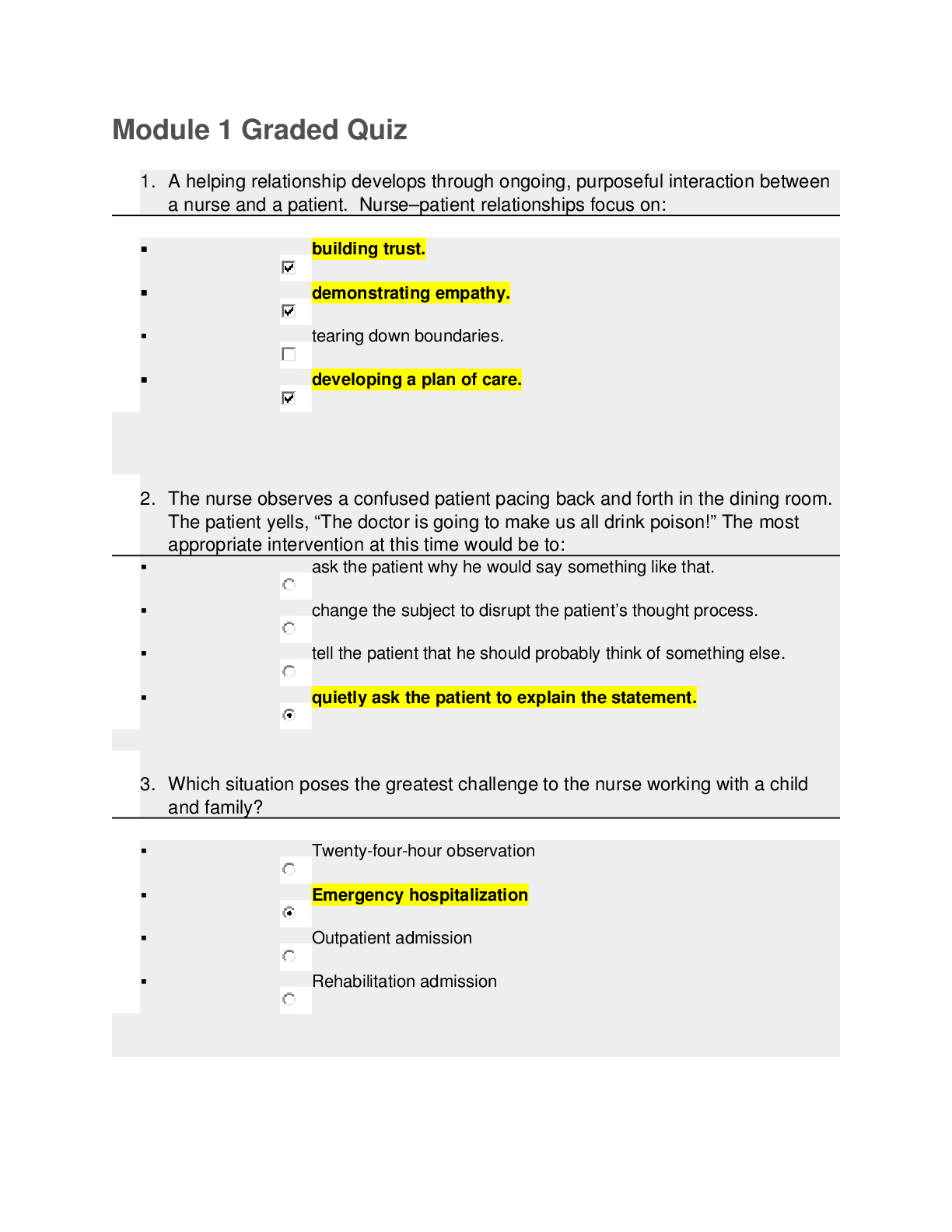
Reviews( 0 )
Document information
Connected school, study & course
About the document
Uploaded On
Jul 19, 2021
Number of pages
28
Written in
Additional information
This document has been written for:
Uploaded
Jul 19, 2021
Downloads
0
Views
32


 And LETRS Unit 8 Final Assessment Test.png)
